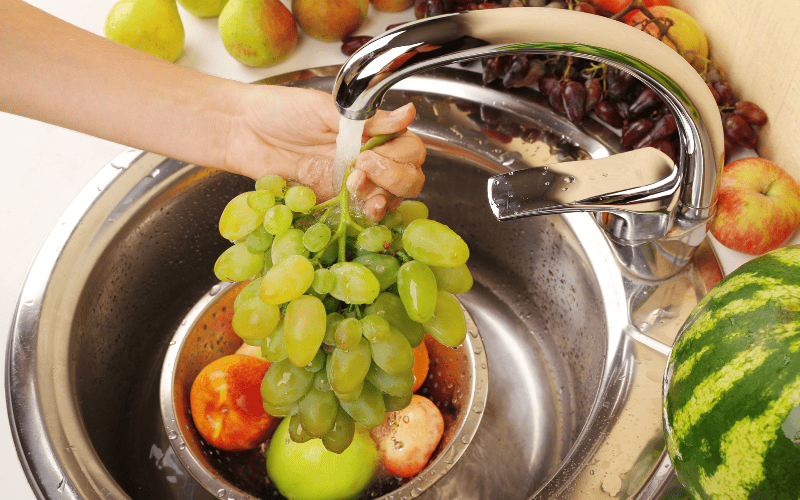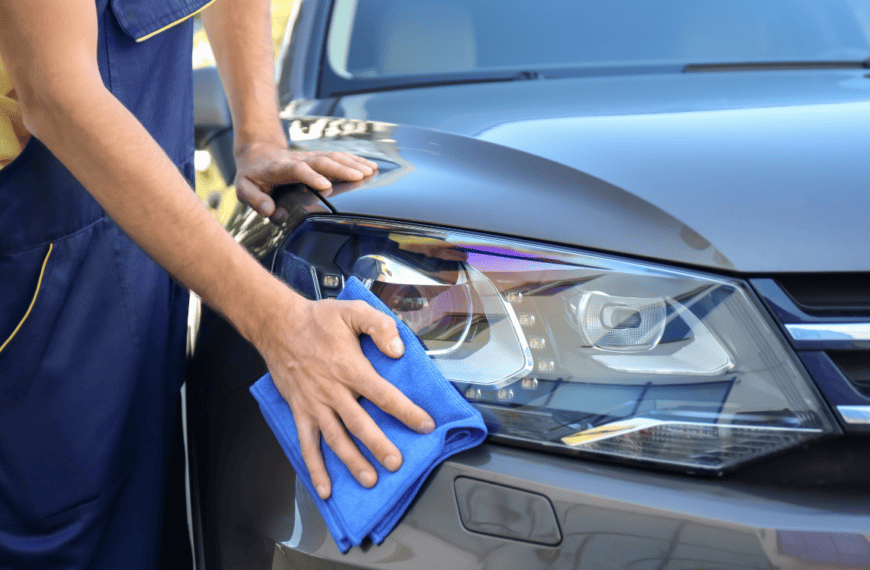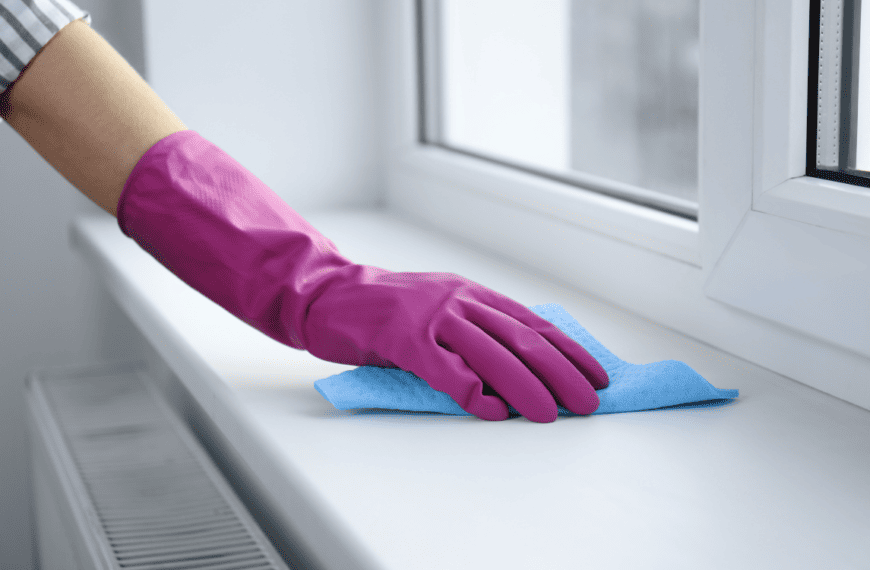If the idea of washing produce with baking soda has you a little nervous, I’ll warn you not to look into the synthetic pesticides, dirt, and debris that could be sitting on your fruit. Let’s face it, sometimes water is not enough to properly clean fruit. For that reason, I’ll show you how to clean fruits with baking soda. I promise it won’t change the taste or impact the longevity of your produce.
Before You Get Started
Before starting with a baking soda wash of your fruit, here are a few important things to keep in mind:
- Not all fruits and vegetables can be cleaned with baking soda; do not try to clean cherries, grapes, or berries with it as their skins will deteriorate
- Do a rinse with cold water before you wash produce in baking soda
- If you are allergic to baking soda, consider alternative methods like vinegar, water, and even lemon juice
Supplies and Tools Needed to Wash Fruit With Baking Soda
Luckily the baking soda method to wash fruits is pretty simple, and you probably have everything you need in your home already.
- Baking soda
- Scrub brush (for fruits and vegetables)
- Bowl
- Clean water
- Running Water
- Drying towel
- Fresh fruits
How To Clean Fruits With Baking Soda
Before you dig into those fresh fruits you picked up from the store today, follow this method to clean your fruit with baking soda. You can also do the same with your vegetables.
Prepare the Fruit to Wash
It’s best to rinse the fruit with cold running water before washing them in a bowl. The initial rinse helps get any of the external dirt or debris off of the fruit so that it won’t soak with it in the baking soda solution.
Step-By-Step Process for Cleaning Fruits With Baking Soda
- Create the baking soda solution; the solution will always be two parts water to one part baking soda. I typically start with one cup of baking soda to two cups of water
- Mix the solution until the baking soda is completely dissolved in the water
- Place a single piece of fruit in the baking soda solution
- Let it sit in this baking soda bath for five to fifteen minutes
- Remove the fruit and then rinse it with cold water
Post Cleaning Steps
Make sure that when washing fruits, you rinse all of the baking soda off the fresh produce. Then take some paper towels or a dry towel and dry the produce so that it is ready to be consumed.
Mistakes To Watch Out For
Baking soda is abrasive, so it will gently scrub the fruit without you having to do much. However, some fruits and veggies are more fragile than others. If you are worried about pesticide residue and other issues, just let the fruit soak a few minutes longer, and use scrub brush to gently scrub.
Alternative Methods To Clean Fruit Before Eating
Even when you purchase organic produce, it doesn’t hurt to do some kind of a wash to clean produce and ensure you are only consuming the good things. These methods also work for vegetables.
Apple Cider Vinegar
Although I like to use apple cider vinegar, you can also use distilled white vinegar when cleaning fruit. Don’t overdo how much vinegar you use; I find that it can be harsh to work with because of its acidity. However, that acidity is what really helps to break down any leftover pesticides and bacteria.
- Pour one part vinegar and three parts water into a bowl
- Mix the cleaning solution
- Place fruit in the apple cider vinegar and water solution for about three minutes
- Take the fruit out and rinse each piece of fruit thoroughly under cold water
- Dry the fruit, and it is ready to eat
Water
Yes, just plain water can clean your fruit. This is the method I follow when cleaning with running tap water. Remember here that plain water rinse will likely not remove or break down all pesticides on the surface of the fruit.
- Ensure you have a clean sink before starting this process
- Take all of the fruits and vegetables that you want to wash and run them under water one by one
- Pull away outer leaves on things like lettuce so that water can access all areas of the food
- Dry all your fruits and vegetables after you have rinsed them thoroughly
BioKleen Natural Produce Wash
If a commercial fruit cleaning solution is a better fit for you, the BioKleen Natural Produce Wash is a great choice. Let’s remember that we are trying to get rid of pesticides and other debris, I recommend using a natural solution like BioKleen.
This is a plant based surfactant that breaks up the surface tension of the waxes, oils and bacterias and allows water to penetrate.
BioKleen can also be used to clean things like cutting boards and the sink after working with produce.
- Rinse all fruit under cold water and place in a bowl
- Add 16 ounces of water to the bowl
- Add one tablespoon of BioKleen Natural Produce Wash
- Soak fruit for about three minutes
- Drain the cleaning solution and rinse all fruit
- Dry fruit thoroughly
Vinegar and Baking Soda
A vinegar and baking soda solution is one of my favorite ways to remove dirt and stains around the kitchen. However, this simple solution is not a great choice for cleaning fruits or even to wash vegetables.
When vinegar and baking soda mix, they create a chemical reaction that can damage your fruits and vegetables.
Why Is Baking Soda the Method of Choice?
Although I’ve given you other tips and advice on cleaning fruit, the baking soda method is the best. Baking soda checks the box for removing dirt, debris, bacteria, and even pesticide residue. In addition, if used properly and on the right type of fruit, it won’t cause any damage.
Different Types of Fruit and What Cleaning Solution To Use
I got a little excited about this concept of soaking produce in baking soda, and I, unfortunately, used it to soak some blueberries. Unfortunately, the skins of the berries started to come off. We had to consume them sooner, and they lost their form. Here are some of the dos and don’ts of cleaning fruit with baking soda.
Soft Skinned Fruits
With soft-skinned fruits, you are going to want to use a large bowl and avoid both hot water and warm water. The baking soda can impact taste if the fruit is left to sit too long.
Most soft skin produce can be dipped in the baking soda for about five minutes without any damage or change in taste.
I would use baking soda on things like:
- Apples
- Peaches
- Nectarines
- Plums
- Tomatoes
- Cucumbers
- Sweet potatoes
Always dry with a paper towel when finished.
Porous Skinned Fruits
With porous skinned fruits, I would use water, a light vinegar solution, or a commercial solution like BioKleen Natural Produce wash. Although it’s great to remove common pesticides, you don’t want your fruit to taste like baking soda either. Certain porous skinned fruits like citrus fruits will soak the baking soda water solution up.
Use one of my alternative methods for:
- Strawberries
- Blackberries
- Blueberries
- Lemons
- Limes
- Oranges
- Grapefruit
- Melons
Methods for Cleaning Leafy Greens With Baking Soda
While you have all of your fruit soaking in the baking soda and water solution, you may be thinking about what to do with those leafy greens. Leafy greens fill a large portion of my refrigerator, and I’m pretty particular about how I wash them.
Baking soda does a great job of helping agitate any of the dirt, debris, and pesticide residue that may be on your leafy greens. Rinsing with just water is not going to remove what baking soda can. Here is the process I follow:
- Rinse leafy greens with cool water
- Fill a large bowl with one part baking soda and two parts water
- Mix the baking soda and water solution well
- Place the leafy greens in the solution and gently rub or shake the greens as they are in the solution
- Remove after about two minutes
- Rinse with cold water
- Dry before eating
Drying and Storing Cleaned Fruits
When you have finished cleaning your fruits and veggies properly, it’s a good idea to dry them. Use paper towels or a clean towel to dry the fruit. Store fruit in containers that allow them to breathe, or put them in the crisper drawer in the refrigerator.
When storing fruits, don’t pile them all on top of each other, as they will rot faster. Also, don’t store dirty fruit next to the ones you have just cleaned.
What Is Baking Soda, and Why Is It Effective for Cleaning Fruit?
Baking soda is also known as sodium bicarbonate. With its alkaline properties, baking soda can raise the pH of the fruit that it comes into contact with. When that happens, it makes removing pesticide residues considerably easier.
In addition, baking soda has a gritty texture that works as a natural and gentle scrubber.
The Importance of Cleaning Fruit
If you haven’t been cleaning your fruit, salad greens, and vegetables, you may want to start now. Here are a few of the most important benefits of cleaning fruit. In addition, you may want to consider buying organic foods and make removing pesticides on fruit a little less stressful.
- Fruit can contain pesticides and bacteria; the thickness of the fruit’s skin can cause some of these pesticides to be absorbed into the fruit
- Baking soda and its alkaline properties help to break down and release some of the pesticides that may still be on the fruit
- Organic fruits and locally grown fruits can still have bacteria and dirt; in addition, if pesticides were sprayed on neighboring fields, there is a chance that your fruits and vegetables could be contaminated
- Fruits can have harmful bacteria, parasites, and viruses that can cause foodborne illness
- Washing fruits will not reduce their nutritional value
- When you don’t wash fruits and vegetables not only could you ingest dirt, bacteria and pesticides it also could end up throughout your kitchen; cleaning fruit can help you keep a cleaner kitchen
Frequently Asked Questions (FAQ)
Is It Safe To Ingest Fruits Cleaned With Baking Soda?
Baking soda is safe for human consumption in small quantities; it is a common ingredient in baked goods. When washing fruit with baking soda, just make sure to rinse thoroughly before consuming.
Does Cleaning With Baking Soda Affect the Taste of Fruits?
Cleaning fruit with baking soda has no impact on the taste; rinse with fresh water after you have soaked in baking soda, and it will taste just as it always does.









